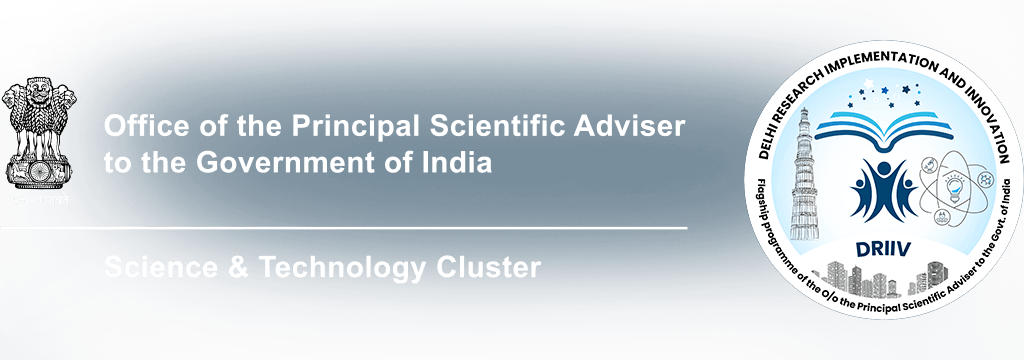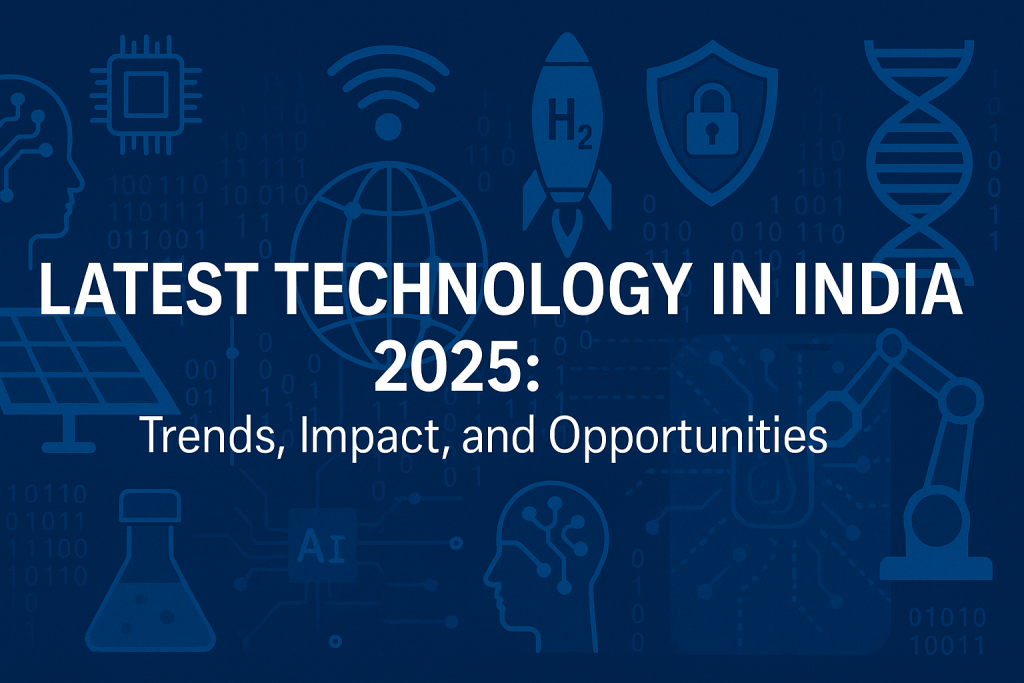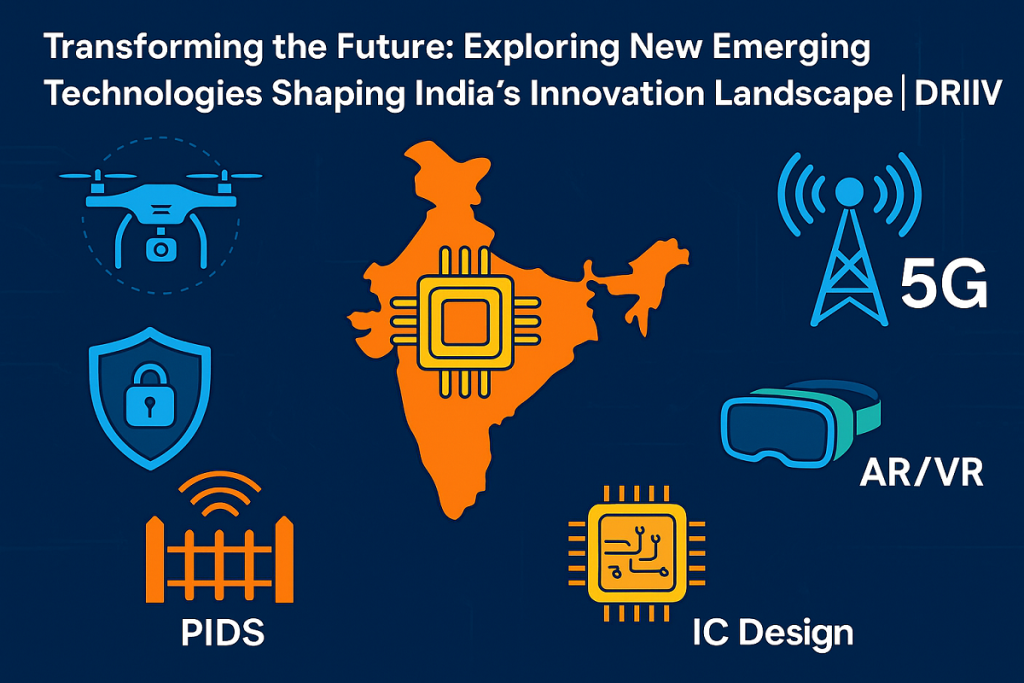India stands at the forefront of innovation in 2025. The wave of digital transformation, driven by the new technology in India, is reshaping industries, empowering people, and unlocking new growth opportunities. From artificial intelligence to clean energy, the country is witnessing rapid advancements that promise to elevate the economy and society alike.
In this blog by DRIIV, we will explore the latest technology in India, its impact, and how it presents countless opportunities for growth, sustainability, and self-reliance. We will also highlight emerging technologies, critical innovations, and future-ready tech shaping India’s journey toward becoming a Viksit Bharat.
1. The Rise of New Technology in India
The year 2025 has brought a significant leap in innovation. Several new emerging technologies have entered mainstream use, transforming sectors like healthcare, education, transport, energy, defense, and governance.
Key drivers behind this transformation include:
- Government initiatives like Digital India, Atmanirbhar Bharat, and Make in India
- Public-private partnerships in R&D
- Investment in Science and Technology Clusters like DRIIV
- Increased focus on startups and indigenous tech innovation
As a result, new technology in India is no longer limited to urban areas. Even rural regions are witnessing the benefits of connectivity, automation, and data-driven solutions.
2. List of Latest Emerging Technologies in India (2025)
India has adopted several breakthrough technologies in 2025. Some of the latest emerging technologies include:
a. Artificial Intelligence and Machine Learning
AI is now being used in agriculture for crop prediction, in healthcare for early disease detection, and in governance for efficient decision-making. It’s a critical technology shaping India’s digital future.
b. Quantum Computing
India has developed indigenous quantum processors and research labs under government-backed initiatives. This critical technology has the power to revolutionize data encryption, logistics, and drug discovery.
c. 6G and Satellite Internet
While 5G is still expanding, India is testing 6G networks and satellite-based internet to connect remote areas, enabling high-speed communication for all.
d. Green Hydrogen and Renewable Energy
Clean fuel alternatives like Green Hydrogen are being developed at scale to reduce carbon emissions. India is a leader in green mobility, biofuels, and solar innovations.
e. Semiconductors and Chip Manufacturing
With global supply chain disruptions, India has started building its semiconductor ecosystem. The new chip fabrication plants are helping reduce import dependency.
f. Biotechnology and 3D Bioprinting
India is using biotech for personalized medicine, vaccine development, and even 3D printing human organs for transplants.
g. Cybersecurity and Blockchain
Digital security is more critical than ever. Blockchain is also being used for transparent land records, e-voting, and supply chain monitoring.
These latest emerging technologies show India’s commitment to innovation-led growth.
3. Impact of New Technology in India
The impact of latest technology in India can be seen across all major sectors:
a. Healthcare
- Remote surgeries and diagnostics through AI
- Affordable biotech solutions for rural healthcare
- Mobile health apps for wellness and prevention
b. Agriculture
- Drone-based precision farming
- AI-poered soil monitoring
- Climate-resilient seeds and smart irrigation
c. Education
- AR/VR-based learning environments
- AI tutors and adaptive learning tools
- Skill-based online certification programs
d. Manufacturing
- Smart factories powered by IoT
- Robotics in assembly and quality control
- Digital twins to simulate production environments
e. Energy
- Renewable microgrids in villages
- Smart meters for efficient power use
- Green fuel innovations for heavy industries
The socio-economic impact of these technologies is huge. They not only increase productivity and reduce costs but also improve quality of life, create jobs, and promote sustainable development.
4. The Role of Critical Technology in India’s Future
Critical technology refers to tech that is essential for national security, economic competitiveness, and social well-being. In 2025, India is investing heavily in such areas.
Examples of critical technologies in India:
- Quantum communication systems for military and secure networks
- Semiconductor design for self-reliant electronics
- AI-driven cybersecurity for digital safety
- Bioengineering for health emergencies
- EV batteries and hydrogen fuel cells for energy independence
By securing these technologies, India aims to reduce foreign dependency, protect digital infrastructure, and lead globally in innovation.
5. Opportunities from Latest Technology in India
With the advancement of new emerging technologies, the Indian market is full of opportunities:
For Startups:
Build AI, clean energy, or biotech-based solutions
Partner with government and academia via S&T Clusters like DRIIV
For Investors:
- Invest in deep tech, agritech, and EV infrastructure
- Support local manufacturing and IP creation
For Youth:
- Get trained in data science, robotics, quantum computing
- Join R&D, tech innovation hubs, or launch your own venture
For the Government:
- Use emerging tech for public service delivery
- Collaborate globally on technology diplomacy
India is positioning itself as a global hub for emerging technologies, and this is the best time to be part of the ecosystem.
6. DRIIV’s Role in Promoting Latest Technology in India
DRIIV (Delhi Research Implementation and Innovation) is one of India’s leading Science and Technology Clusters, dedicated to solving societal challenges using innovation and research.
At DRIIV, we focus on:
- Technology co-creation with industry and academia
- Sustainable development through clean energy and water innovation
- Health tech and air pollution control solutions
- Mobility and manufacturing tech for the future
By bringing together scientists, entrepreneurs, policymakers, and citizens, DRIIV enables the adoption of new technology in India for real-world impact.
7. Future of New Emerging Technologies in India
Looking ahead, we will see:
- AI copilots in every profession
- Fusion energy research becoming mainstream
- Space tech startups building satellites
- Brain-computer interfaces in medical treatment
- Climate-resilient infrastructure powered by IoT and ML
India’s technological journey is just beginning. With proper support, policy, and innovation, it can lead the global tech revolution.
Conclusion
The latest technology in India is more than just advancement; it is a catalyst for inclusive growth and transformation. From AI to Green Hydrogen, from 6G to biotech, the new emerging technologies in 2025 are building a smarter, cleaner, and stronger nation.
As a responsible innovation cluster, DRIIV is proud to be at the center of this journey, collaborating with thinkers, doers, and policymakers to bring real change through technology.
Let us embrace these trends, understand their impact, and seize the opportunities to shape a better future for all.
Frequently Asked Questions (FAQs)
Q1. What are the new technology trends in India in 2025?
In 2025, key trends include AI, 6G, quantum computing, green hydrogen, biotech, and advanced semiconductors. These technologies are transforming industries and improving lives.
Q2. What is meant by critical technology?
Critical technology refers to technologies vital for national security, economic independence, and essential services. Examples include quantum tech, chip manufacturing, cybersecurity, and energy innovation.
Q3. How is DRIIV contributing to new technology in India?
DRIIV supports co-creation of technology through collaboration with academia, industry, and government. It promotes innovation in clean energy, health, mobility, and sustainability.
Q4. Why are emerging technologies important for India?
Emerging technologies help India solve local challenges, boost economic growth, reduce imports, and make services more efficient and inclusive.
Q5. What opportunities are available in the latest emerging technologies sector?
There are opportunities for startups, investors, students, and researchers in sectors like AI, EVs, biotech, green energy, and quantum computing. Government support and funding are also increasing.




